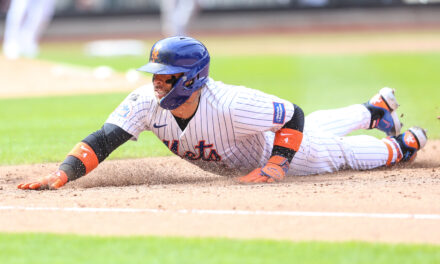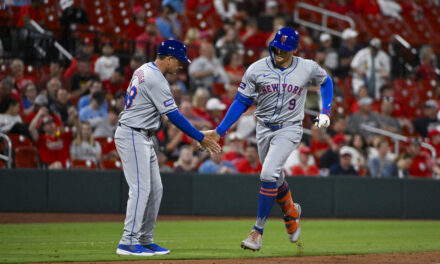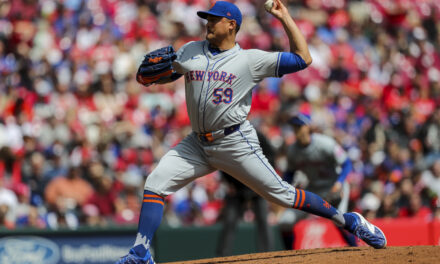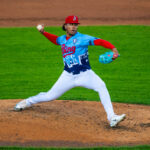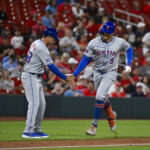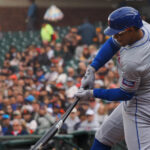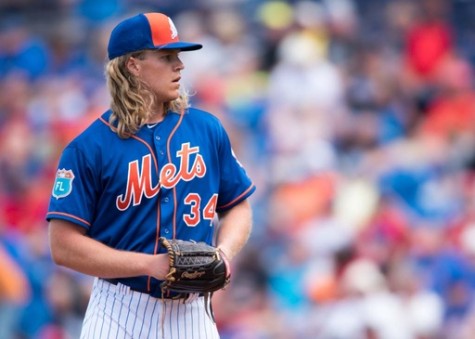
Noah Syndergaard continues dominating the National East, holding the Washington Nationals offense to five base runners allowing the New York Mets two solo home runs to carry the Mets to a 2-0 victory.
Syndergaard’s combination of velocity and sharp movement on all four of his pitches is officially a spectacle many MLB hitters have never seen before. But Syndergaard’s command of these four pitches is the glue between his great repertoire of pitches and high level of success.
Noah Syndergaard (W, 4-2) 7.0 IP, 0 R, 5 H, 10 SO, 0 BB
Syndergaard showed tremendous command with each of his four pitches above a 60% strike rate, living low in the zone throwing 67 of 98 total pitches (68.3%) located approximately at the opposing hitters groin level and below.
How does this help Syndergaard?
Keeping pitches low in the hitting zone helps Syndergaard induce ground balls early in at-bats. Since ground balls are generally hit softer than fly balls, this creates easier outs for the Mets defense. Since hitters are swinging earlier in the at-bat more often, this helps reduce pitch count due to fewer deep at-bats. Additionally, this reduces walk rates due to fewer three-ball counts (deep at-bats).
Last night, this sequence was crystal clear. Syndergaard produced a 57.1% ground ball rate comparing to the league average of 44% with most ground ball pitchers are considered to have above 50% rate. This translated to his highest soft contact percentage of the season at 35.7%, meaning 35.7% of balls in play from Nationals hitters were considered “soft contact” or poorly hit. Additionally, Syndergaard produced his second lowest hard contact percentage of the season at 21.4%.
Finally, Syndergaard surrendered no walks, getting to only two three-ball counts.
Mets Offense Hunting Fastballs
Great seeing Curtis Granderson swinging at a first pitch fastball for his seventh home run of the season. The SNY broadcast showed an interesting stat: Granderson has the lowest first-pitch swing percentage in the National League (min. 60 PA) but when swinging at the first pitch he is 2-for-5 with 2 home runs.
Against MLB pitchers, especially top tier pitchers like Max Scherzer, the deeper an opposing hitter gets in an at-bat, the greater chance the at-bat ends in an out.
Mets hitters showed a much better approach than their road trip, aggressively swinging at 50% of Scherzer’s first and second pitch fastballs (13 of 26). Additionally, Mets hitters only took a fastball for a called strike in 0-0 or 1-0 counts in six of their twenty-five at-bats against Scherzer (24% of at-bats).
Conversely, in the Mets May 5th game against the San Diego Padres Colin Rea (Rea carried a no-hitter into the seventh inning) Mets hitters took a fastball for a called strike in 0-0 or 1-0 counts in fourteen of their twenty-eight at-bats against Rea (50% of at-bats).
This comparison is proof Mets hitters need to continue swinging early and often at fastballs.
Reed to Familia
The bullpen didn’t surrender a base runner as Addison Reed seamlessly passed the baseball to Jeurys Familia for Familia’s thirteenth save this season.
Max Scherzer Dominated by Home Runs
There’s an interesting article on FanGraphs by Paul Sporer explaining Scherzer’s struggles allowing home runs off fastballs. Since the start of 2015, Scherzer is throwing 5% more fastballs in the strike zone with fastballs in the upper half of the strike zone up 11% compared to 2013-2014 seasons. This translates to a 4.7% home run rate (HR/Batters faced) since July 12th 2015, the highest home run rate in MLB.
Stat of the Night
Syndergaard is 8th in MLB with a 56.6% ground ball rate.
Follow Chris Zaccherio on Twitter @ziography for more Mets insight going beyond statistics.


